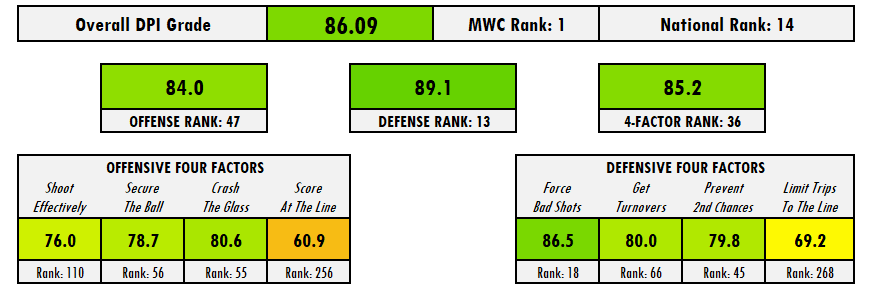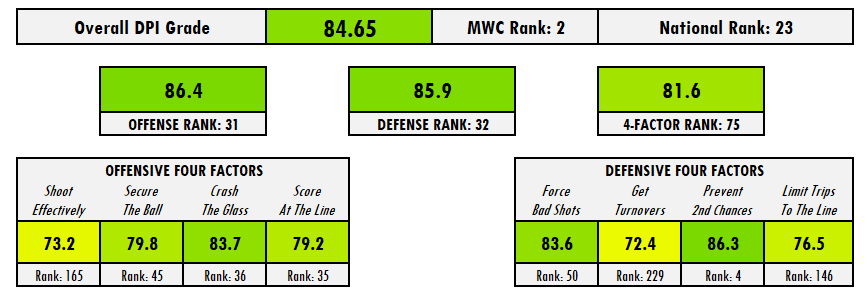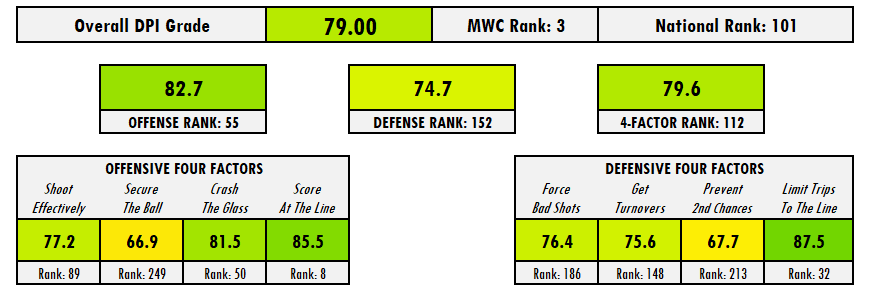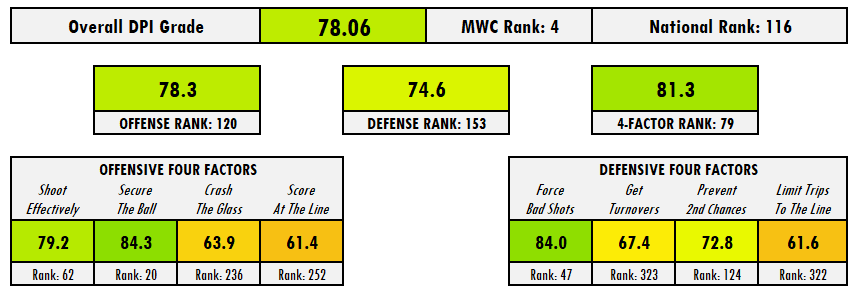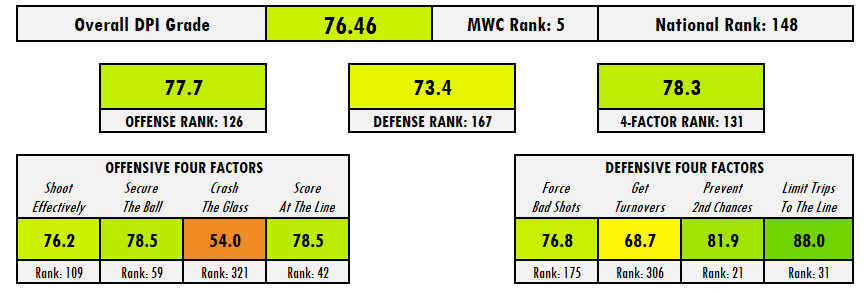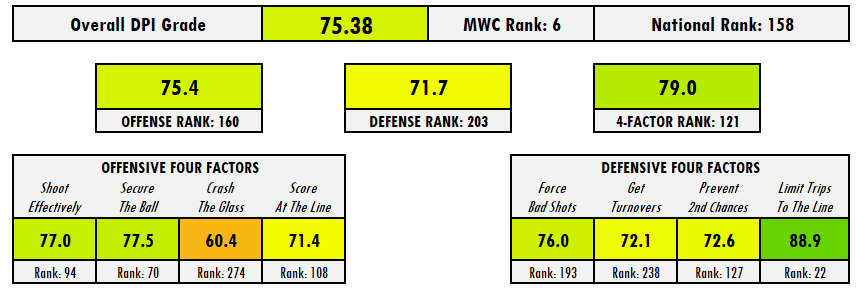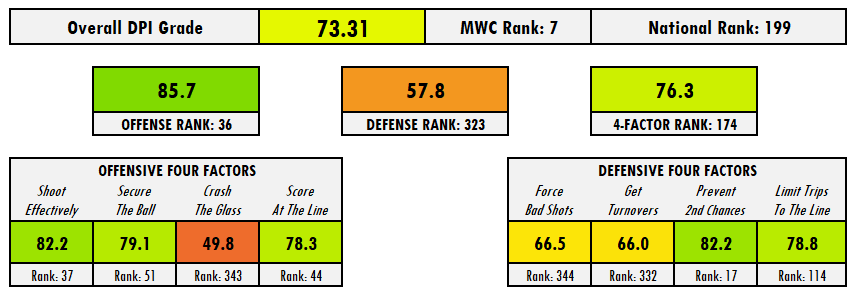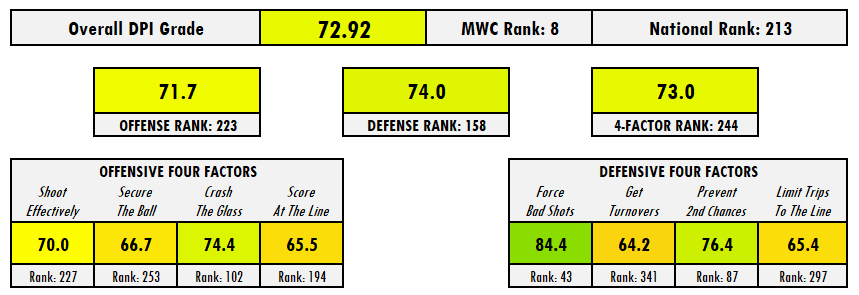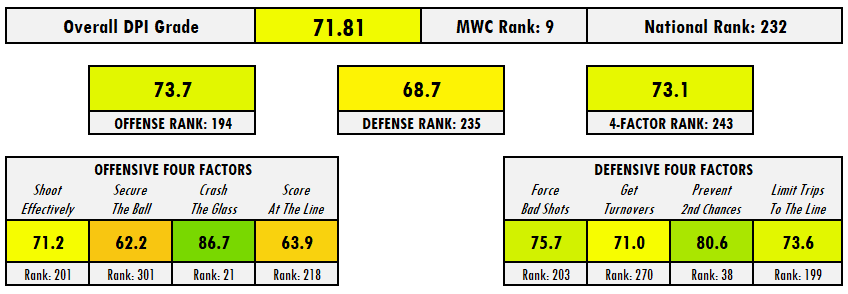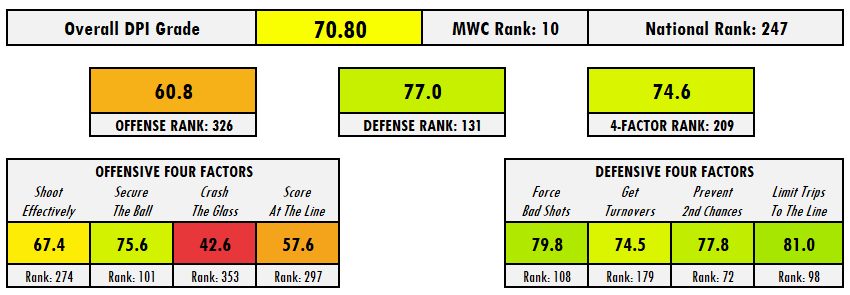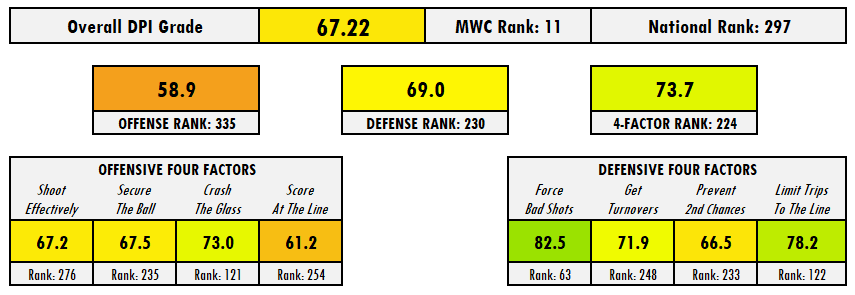[jwplayer 9FEfL71c]
NCAA Bracketology: Is San Diego State Still a #1 Seed?
Comparing the Aztecs’ resume to other top teams
Contact/Follow @andrewdieckhoff & @MWCwire
SDSU has just one loss, but did they just lose their spot on the one line?
For months, as San Diego State’s unbeaten streak grew and grew, the Aztecs became more comfortable with the idea of being a #1 seed in the NCAA Tournament.
But after Saturday’s loss to UNLV, Brian Dutcher’s club has fallen from the annals of history—but perhaps not from the top line. With the top six teams having separated themselves to this point of the season, and with four of those teams losing last week, the debate surrounding the top seeds is growing to a fever pitch.
In order to determine whether the Aztecs should retain their place on the one-line, let’s take a gander at how they stack up against the other teams in the conversation. But any investigation of a team’s case starts with their own resume.
San Diego State
San Diego State still has the fewest losses in the country after Gonzaga and Baylor also incurred defeats over the weekend. They have 25 wins against Division I opponents, including a perfect 9-0 record in games falling in the NCAA’s Quadrants 1 and 2.
The Aztecs also went 4-0 against their Quadrant 1 opponents—even more impressively, all four of those games were played away from Viejas Arena.
Their opening week win over BYU has aged beautifully, as has a Thanksgiving break romp over Creighton and Iowa in which San Diego State won both games by a combined 41 points. A January win in Logan over Utah State was the only truly valuable win for the Aztecs in league play.
As of Monday night, San Diego State was ranked in the top ten of every major advanced metric except the Kevin Pauga Index, which primarily rewards teams that play difficult schedules.
That brings up the question of the Aztecs’ schedule.
Their season-long strength of schedule is rated outside of the top 100 nationally. Before blaming that on their playing in a middling Mountain West conference, note that San Diego State’s non-conference SOS is also outside the top 100.
This aspect of San Diego State’s resume is their weakest, but it’s still a very strong profile. The real question is: how does it stack up against the other teams in the mix for a top spot?
The Competition
For ease of argument, let’s say that Kansas and Baylor have locked in two of the #1 seeds already. Each of those teams boasts ten-plus wins in Quadrant 1. They are ranked 1-2 in five of six metrics, with only the BPI ranking the Bears outside of the top two.
They’re pretty much locked in at this point, barring some unforeseen disaster.
But after the Big 12’s big two, the conversation opens up quite a bit.
Currently, the main competitors facing off with the Aztecs for those last two spots on the top seed line are Gonzaga, Duke, and Dayton. Others such as Maryland, Florida State, and Creighton might still have an outside shot at getting a top seed, but they are all currently on a tier just below the top six.
For now, we’ll focus on the three teams bunched most closely with San Diego State, starting with the team that is geographically closest to them.
Gonzaga
Of the quartet, Gonzaga likely has the strongest case to get a #1 seed. The Bulldogs are 27-2 and their only losses have come against NCAA tournament locks BYU and Michigan. While it may be tempting to compare the Zags’ loss to BYU against San Diego State’s win over the Cougars, bear in mind that star big man Yoeli Childs was not in action against the Aztecs. (Also, Gonzaga crushed the Cougars in the first matchup, winning 92-69 in Spokane. That seems important.)
Gonzaga has the edge in the analytics over San Diego State, rating higher in every major metric except for KPI, where the Zags are one spot behind the Aztecs at #15. So, that’s a check in the win column for the Bulldogs.
But while the computers may prefer Gonzaga, their best wins are no better than SDSU’s. They both have wins over BYU, and while the Zags also have wins away from home over Oregon, Arizona, and Saint Mary’s, the Aztecs’ wins over Creighton, Iowa, and Utah State are just as good or better.
The similarities between Gonzaga and San Diego State don’t stop there.
The average NET ranking of San Diego State’s triumphs is 158, the second-worst number among the handful of teams vying for a #1 seed. Only Gonzaga’s average NET win is worse, at 163.
It’s hard to tease the two teams apart. Their respective resumes have similar strengths and weaknesses, so any argument against one team can likely be used against the other. For the moment, though, Gonzaga’s edge in the computer rankings likely has them ahead of the Aztecs by a nose.
Dayton
Dayton is also in that neighborhood, with their average NET win coming in at 140. The Flyers have played a tougher schedule than either the Aztecs or Zags, but they lack a true marquee victory. There were chances for glory, most notably in neutral-site games against Kansas and Colorado, but Dayton fell to both in overtime.
Their best wins have come against some of the country’s best mid-major programs, including Saint Mary’s, Rhode Island, Richmond, VCU, and Saint Louis. They also scored wins over top 100 programs in Virginia Tech and Georgia.
But while Dayton’s wins might not jump off the page, the Flyers do perform well in the computer rankings. As of Monday night, they were ranked in the top four of both the KPI (#3) and the NET (#4). That’s higher than San Diego State ranks in any metric, although it does bear mentioning that the Aztecs do better than Dayton in predictive ratings such as KenPom, Sagarin, and BPI.
Led by potential Naismith winner Obi Toppin, the Flyers are very fun to watch. But without a signature win to hang their hat on, it’s hard to see them surpassing Gonzaga or San Diego State in the race for a #1 seed—especially with the rest of the Atlantic 10 faltering down the stretch. No matter who Dayton draws in the A-10 Tournament, they won’t get another opponent that compares to the top wins of the top six.
Duke
That just leaves Duke. Do the Blue Devils have what it takes to steal a spot on the top line?
Mike Krzyzsewski has another winner on his hands in Durham, with Duke currently sitting at 23-4 on the season. The Blue Devils have one of the best wins available this season, and they got it on opening night when they beat Kansas during the Champions Classic in Indianapolis. Only Baylor’s victory over the Jayhawks in Lawrence is better, on paper.
Duke also holds a home victory over Florida State and a road win against Michigan State. Their trio of top wins outclasses San Diego State’s grouping of Creighton, BYU, and Iowa. Still, like the Aztecs, the Blue Devils have just four Quadrant 1 wins.
Duke also joins SDSU as the only teams in the top six that have a Q3 loss.
The Blue Devils’ much-maligned home loss to Stephen F. Austin has actually aged quite gracefully, moving from Quadrant 4 to being a borderline Quadrant 2 game. While the Lumberjacks would still need to climb at least dozen spots in NET rankings to move this game up to Q2, they are currently about 25 spots higher in the NET than UNLV is.
Coach K also has the advantage in the analytics, with his team averaging out to be a top 5 team across the six major metrics. They are currently #1 in the BPI, and their lowest ranking is a #9 placement in ESPN’s Strength of Resume measurement. They are also in the top four of both the KenPom and KPI rankings.
The differences between the teams are quite slim. One of the main distinguishing factors that plays in San Diego State’s favor is that, while the Aztecs are undefeated against top competition, Duke has three losses in Quadrant 1. They have had more opportunities for such games, but the road losses to NC State and Clemson might be an anchor that keeps Duke from rising to the top.
That said, the ACC Tournament could provide the Blue Devils with plenty of opportunities for high-quality wins, so winning out could earn them a #1 bid. It remains to be seen which of the western teams they would push out—Gonzaga or San Diego State?
The Verdict
In view of the explanations above, here is how the selection committee might currently view the top six teams:
- Kansas
- Baylor
- Gonzaga
- San Diego State
- Duke
- Dayton
As of right now, as long as San Diego State wins out and takes home the MWC Tournament title, they should hold on to the #1 seed that they earned with their incredible start to the season. The same can be said for Gonzaga. Those teams are the front-runners for the final two spots on the top line right now. The Bulldogs’ edge in the computer rankings likely has them sitting ahead of SDSU at the moment.
The biggest threat to the Aztecs’ top seeding, then, will be Duke. The Blue Devils could possibly surpass SDSU (and/or Gonzaga) if they win the ACC Tournament and score wins over Louisville and Florida State in the process. Dayton is also still in the conversation thanks to a great record, good metrics, and one of the most electrifying players in the country.
But for San Diego State, the mandate to earn a #1 seed is clear: win and you’re in.
Andrew is a current USBWA member, covering college basketball for multiple outlets, including Mountain West Wire of the USA TODAY Sports Media Group and Busting Brackets of the FanSided Network. He also runs the Dieckhoff Power Index, a college basketball analytics system, and provides bracketology predictions throughout the season.
[lawrence-auto-related count=3 category=1361]















